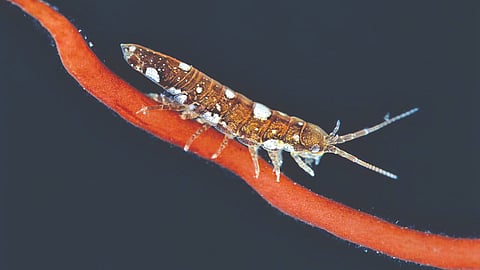

By ANNIE ROTH
Move over birds and bees, there is another pollinator on planet Earth, and it lives in the sea. In a study, published Thursday in the journal Science, scientists found that a tiny crustacean, Idotea balthica, played the role of pollinator for a species of seaweed. They do this by inadvertently collecting the algae’s sticky spermatia, its equivalent of pollen, on their bodies and sprinkling it around as they move from frond to frond in search of food and shelter. This is the first time an animal has been observed fertilizing an algae. This discovery not only extends the scope of species that use this reproductive strategy, it also raises questions about whether it first evolved on land or in the sea.
It was long thought that animals only pollinated plants on land. However, in 2016 scientists discovered that zooplankton pollinate Thalassia testudinum, a sea grass species found in the Caribbean. Sea grasses are the only flowering plants that grow in marine environments, but they remain closely related to terrestrial plants. Seaweeds on the other hand, while technically plants themselves, are not closely related to terrestrial plants.
The discovery that Thalassia testudinum was pollinated by animals was made after scientists noticed an unusually high density of marine invertebrates visiting sea grass flowers. Shortly after this discovery, Myriam Valero, a population geneticist at Sorbonne University in France, observed something similar happening among the red algae she was studying. The seaweed species she was studying, Gracilaria gracilis, always seemed popular with invertebrates, specifically the isopod species Idotea balthica. Because Gracilaria gracilis produce spermatia that, like pollen grains, cannot move on their own, Dr. Valero wondered if the isopods might be playing a role in the spermatia’s dispersal. Earlier studies suggested that the spermatia of Gracilaria gracilis were dispersed by ocean currents, but given their abundance in calm coastal rock pools, Dr. Valero suspected another dispersal mechanism was at play.
To test her hypothesis, Dr. Valero and Emma Lavaut, a graduate student at Sorbonne, grew male and female Gracilaria gracilis and placed them six inches apart in seawater tanks. Half the tanks were populated with the tiny crustaceans, while the others were not. At the end of their experiment, they found that fertilisation occurred around 20 times as much in the tanks with the isopods than in the tanks without them.
In a subsequent experiment, the researchers took crustaceans that had spent time in tanks with reproductive male Gracilaria gracilis and transferred them to tanks with unfertilised female algae. They found that doing so also resulted in high rates of fertilization. They examined the isopods under a microscope and found that they had spermatia stuck to nearly every part of their bodies.
The researchers believe the isopods have a mutualistic relationship with the seaweed. The algae provides the isopods with food in the form of a species of microalgae that grow on its surface as well as shelter. In exchange, the isopods help fertilize the algae.
Visit news.dtnext.in to explore our interactive epaper!
Download the DT Next app for more exciting features!
Click here for iOS
Click here for Android